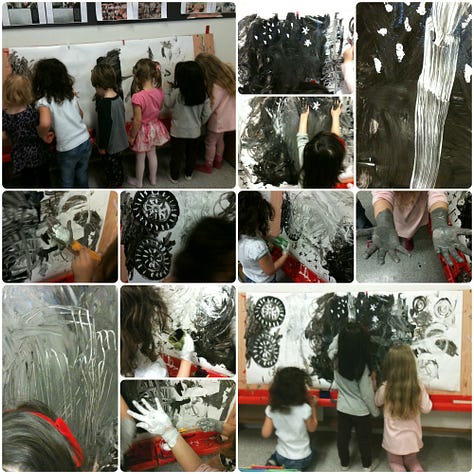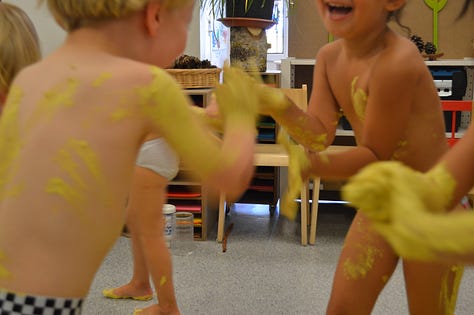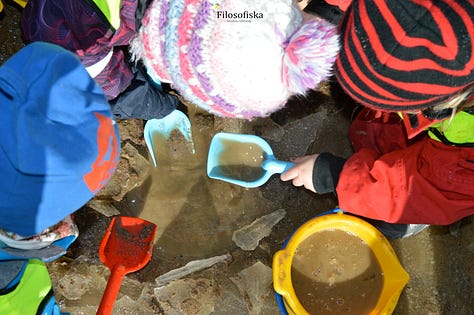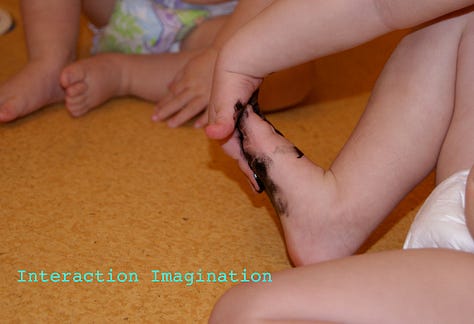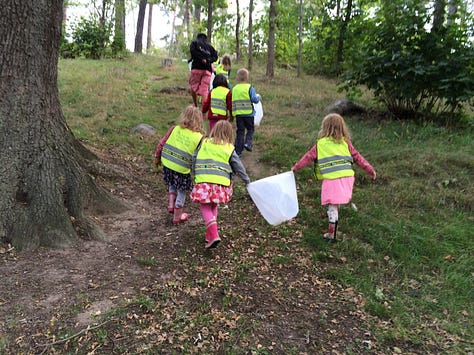Good Trouble
I am back in Stockholm, reflecting on my visit to Michigan, and preparing for the fourth module of the playarista training next week.
I keep thinking about about the dynamic of niceness and kindness and how they are often confused - see my post A Pedagogy of Care where I wrote
“Kindness requires us to think. To consider how others feel. To accept we make mistakes, and that apologising and making an effort not to repeat them is an important part of kindness.
Kindness is not the rote use of please, thank you and sorry.
Kindness is found in genuine gratitude and regret.”
And I keep thinking about how do we observe and document kindness? How do we teach kindness? And, how do we avoid teaching children to use hollow politeness and niceness? Because, what happens when the glove of niceness is taken off and there is no kindness underneath?
In my current reflections I think kindness cannot be taught. That it is an innate gift we all have and needs to be collectively nurtured through genuine experiences as well as kindness being modelled and kindness been shown towards us.
This is why I repeatedly say that it is an absolute must that it is the adults that must always be kind - and that children are practising how to express their kindness. My deep rooted belief is that all people seek to belong one way or another, and that much of our actions and choices are connected to seeking out those we can belong with, or adapting ourselves so we can belong. Being kind is a part of that, knowing how to express kindness so that others recognise it is another thing. Because we are all raised in slightly different contexts - in some families lots of hugging and kissing is how love and kindness is shown, in other families it is through collaboration, in other families through food, or through words or … There is not one way to express kindness.
Politeness and niceness are strategies for learning how to express kindness so that others recognise it. The please and thank yous, the sorry, phrasing things as a question rather than a statement or a demand.
Sometimes I hear parents ask their child a question when in reality it is a demand - but they want to package it in a “nice” way. This gives the illusion of autonomy, but when the child does not select the answer the parent wants, or does what the parents needs then the “choice” is revealed as a demand. It would be much better to say the demand kindly than to be false with a child - because eventually they will work out the manipulation.
It would be much better to say gently “In five minutes we need to leave, so that we can get home to make dinner”, than ask “Shall we go home now and make dinner?” when there is no real choice. There is an illusion of giving the child agency, but only as long as the child is in agreement with the adult. I don’t think we are being kind by tricking them in this way.
Real agency comes from real choices and informed decision making. Our roles as parents and educators is to ensure that we are offering safe and brave choices while at the same time scaffolding the children to be able to make more and more advanced informed decisions.
I also think that learning how to be kind cannot be nurtured in an environment where everyone is fake nice. I remember watching a group of four 4 year olds struggle with their collective play flow - despite it being calm and harmonious - the four children would continuously say “I am not keen on that” or “I don’t like when you do that” when the play did not go exactly as they wanted. There were no learned skills as to how to enter flow, only skills to politely prevent flow.
Just because children are playing alongside each other quietly, and saying the “right phrases” does not mean we have a successful learning and play environment.
I intervened with this group and started asking the questions they needed to be able to enter a state of collective flow - because sometimes that requires good trouble. Arguments, loudness and sometimes some pushing and shoving can all be a part of learning kindness and not a hinderance of learning kindness. For instance, rough and tumble play, while seemingly boisterous, can be a valuable tool for developing empathy and social skills in boys. It teaches them to understand social cues, regulate their emotions, and build stronger relationships with peers. And without empathy, understanding social cues and the ability to regulate our own emotions being kind to others (and ourselves) because hard.
So what skills are needed in order to be kind?
Active Listening (listening to understand, rather than reply)
Paying attention to what others are communicating, in words (spoken, written, signed) and through the arts.
Understanding the perspectives of others and showing genuine interest in their experiences.
CuriosityandJoy
Empathy
Recognising and understanding the emotions of others.
KnowledgeBeing able to put oneself in another person's shoes and share their feelings. And responding appropriately.
Imagination
Patience:
Allowing
timefor others to express themselves without interruption or judgment. This takes self-regulation.Accepting that everyone has their own pace and that mistakes are a part of learning.
Communication/Interaction:
Expressing thoughts and feelings clearly and respectfully.
Choosing words carefully to avoid causing offence or hurt.
Reflection Knowledge Imagination
The following skills are also needed…
Respect: Treating everyone with dignity and consideration, regardless of their background or circumstances.
Confidence: Being comfortable with oneself and having the courage to express kindness, even in challenging situations. Risk taking
Willingness and openness to learn: Being open to new experiences and perspectives, and continuously seeking opportunities to grow in kindness. wonder and curiosity
Adaptability: Adjusting one's approach to kindness based on the specific situation and individual needs.
Informed decision making: Being able to navigate disagreements and find solutions that are fair and respectful to all involved. knowledge imagination risk reflection
Some of the words above I have highlighted because they are the essential threads of the Original Learning Approach. Not only do these threads help us to bring our teaching closer to where children can experience a state of learning flow (that feels almost or as good as play flow) but also enable us to respond with kindness and to foster kindness within the whole play-ecosystem and beyond.
I think we should be designing experiences for children to experience good trouble. Situations that allow them to experience both kindness and things that make being kind tricky without practicing all the above skills. If children are only allowed to be nice and calm and harmonious all of the time, how do they get to practice being kind when others are angry, frustrated or being rude - or know how to defend themselves without escalating the situation, or know how to be kind when in new circumstances that requires them to overcome known and unknown bias and prejudice, or fears.
When I first started the Together Paintings, (a safe and brave space to practice the skills need to be kind), I needed to have a list of the children who wanted to paint - a turn-taking list, as there were so many heated disagreements about who should paint and when. The risk of it not working at all was too great, the children were still learning to trust each other and trust me, so the list became a visual tool that reassured them that they would get a turn.
There were two pots of paint, one black and one white, each with a brush. The idea being that the children needed to talk to each other about swapping colours... giving them the chance to learn how to ask respectfully, how to say no respectfully, to be aware that others are waiting - and if you don't like to wait, maybe others don't either (theory of mind) and also to learn how to self regulate in order to wait - if you don't like having to change colours frequently, maybe others don't either? This was a way for the children to learn how to socially interact with each other. It was not conflict free, but I was there to support them if needed, by asking questions, and modelling sentences that could be used. After a week the children did not need the turn-taking list any more, they were able to organise themselves verbally. I have vivid memories of children standing a few centimetres away from another child’s ear, asking passionately "is it my turn yet?" on repeat. They learned that there was time to paint, that they could play and return to the Together Painting repeatedly and have several turns during the day. We also expanded how many children could stand at the wall easel and how many pots of paints were available as the children mastered the skills of negotiation.
The children needed to learn that there was time... and everything did not need to happen now... and that others could be first sometimes and that is OK.
extract from The Original Learning Approach
